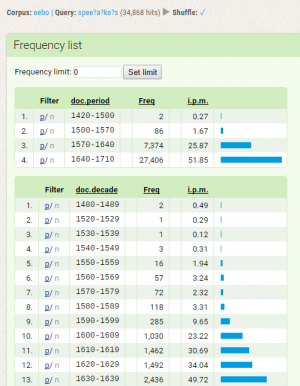Table of Contents
Lesson 3: Competing forms
Language change often takes place as a result of one emergent form replacing an already existing one. Variation within language leads to the advent of a new form, which may or may not go on to replace the older one. This process generally takes place over the course of decades or centuries, and therefore is observable in the EEBO corpus. One of the most widespread changes taking place in the sixteenth and seventeenth centuries was the adoption of a new third person singular ending < -(e)s>.
Third person singular endings < -eth> and < -es>
Early Modern English, the third person singular ending in the present tense had two possible realizations. The older form, the now archaic < -eth> or < -th>, originated from the OE < -eþ> and was still the dominant variant at the beginning of the period. From the Northern dialects of English there came the form < -s> or < -es>, which gradually began to replace. For most of the Early Modern English period the two forms coexisted. Therefore texts written in the sixteenth century may contain both knows and knoweth, both appears and appeareth.
Searching the corpus
What we want is a comparison of the use of the < -(e)s> and < -(e)th> endings. This is best done by conducting two separate searches, one for the < -(e)s> variants and another for the < -(e)th> variants. The results can then be turned into a graph which will show the development of the two variants side by side. Ideally, we would have one search for all singular verbs ending in < -(e)s> and all singular verbs ending in < -(e)th>. However, because the corpus does not contain information about word classes (is not lemmatized), it is best to select one high frequency verb such as speak, and search for all of its forms in the third person singular.
Both speakes (with the silent <e>) and speaks occur in Early Modern English, and should be included in the query. This can be expressed with the help of the vertical bar thus:
[word=“speakes”]|[word=“speaks”]
We can further simplify the queries by using another regular expression, the question mark ?, which indicates that the element directly preceding it is optional. With this symbol, there is no need to add the second pair of brackets - the query can be simplified thus:
[word=“speake?s”]
[word=“speake?th”]
Question: Are there any potential problems with the way we have written our query? Are we forgetting something?
Because we know that there was a substantial amount of spelling variation in the period covered by EEBO, we should modify the query in order to accommodate all the widespread spelling variants. As mentioned in Lesson 2, it is always advisable to consult a reliable source, such as OED Online, when searching for a specific lexical item, due to the existence of a number of possible forms (spelling variants). In the case of speak, the other frequent variants are speeke, speek, speke and spek, and we should therefore include these forms in our searches:
[word=“spee?a?ke?s”]
[word=“spee?a?ke?th”]
After we input the query, we get a concordance view of the results, containing all the forms we have included in the search. What we need is a breakdown of the results by period, so that we can see the development of the variants over time. Frequency → Text Types on the menu bar shows us a list of frequencies by period and by decade. By default, the results are ordered by frequency. By clicking on the text doc.decade we can order the results chronologically.
The frequency list by period and decade for the < -es> ending:

The table can be simply copied into a spreadsheet application (for example Excel) and a graph made based on the i.p.m. of the forms. It is essential to use the frequency count per million words (i.p.m) because the size of the texts varies with every decade, and viewing the results in relative terms (rather than absolute) ensures the most accurate representation. Please note that if there are no occurrences in a given decade, it is not displayed (e.g. 1480-1489 for the ending < -(e)s>)
The graph showing the coexistence of the third person singular endings < -eth> and < -es>:

The graph shows that in the fifteenth century, the dental < -(e)th> ending was essentially the only available one for the present tense of the third person singular. At the beginning of the seventeenth century, the Northern forms with < -(e)s> began to appear and by as early as 1640 they were in the majority. The question is whether the process was the same for other verbs, or whether verbs with lower frequencies were more (or less) resistant to the adoption of a new ending.
Task: Try another verb
- Select another verb to see if the results will be similar to those for speak
- Try for example give, make or show
- Keep in mind all possible spelling variants
- Make sure that the Query type is set to CQL
- Create a graph to show the results
If you are ready, you can continue to Lesson 4.







